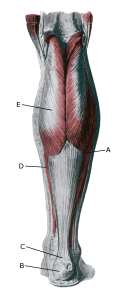Anatomy

A. M. soleus
B. Tuber calcanei
C. Tendo calcaneus (Achillis)
D. M. gastrocnemius

Cause
With repeated, consistent (over)exertion (running, football), the calf muscles at the Achilles tendon attachment overload the growth zone of the heel (calcaneus), causing an irritation with ‘inflammation’ in the growth zone (apophysitis). The condition is called Severs syndrome and is very common and is typically seen in athletic 8-12 year olds.
Training load should be reduced during periods of rapid growth (measure the height of young athletes every 3 months). Training should generally be varied and avoid repetitive movements. Alternate between different exercises over time to reduce strain. Quality of training is more important than quantity.
Symptoms
Slow onset of pain when activating (running, pushing off, toe walking) and stretching the Achilles tendon. There is pressure tenderness at the back of the heel bone. In about half of adolescents with Severs syndrome, the symptoms are bilateral.
Examination
Diagnosis is usually made by a general clinical examination, where the known pain can be induced by simultaneous external and internal pressure on the Achilles tendon attachment on the heel bone (calcaneus squeeze test). For more pronounced tenderness, sudden onset or prolonged pain, a medical examination is recommended to ensure proper diagnosis and treatment.
If there is any doubt about the diagnosis, an ultrasound scan can be performed. The ultrasound scan will assess the extent of changes in the tendon attachment (enthesitis) and in the growth zone (apophysitis) with inflammation and possible fragmentation (irregularity) of the growth zone, which is often seen in severe cases.
Ultrasound scanning can thus help to grade the severity of the injury. X-ray, MRI and CT scans are only indicated if there is doubt about the diagnosis.
Treatment
Treatment primarily consists of relief from the pain-inducing activity (running, jumping) as the growth zone cannot be trained stronger (Hernandez-Lucas P. et al., 2024). It is important to maintain muscle and tendon function on the leg with muscle exercises and stretching.
If treatment is started quickly, the injury can sometimes heal in a few weeks, but it is not uncommon for long-term symptoms to last longer than half a year. Once the pain has subsided, sports activity can be slowly increased within the pain threshold.
The growth zone on the heel bone usually closes after the age of 15, after which the discomfort often fades permanently with no ill effects. Only modest effects of orthotics and special shoes have been documented (Uvelli K. et al., 2017).
It is important that the athlete, parents and coaches are informed, understand and respect the need for load management during the rehabilitation period in order to avoid long-term injuries that can extend over six months and years (Fares MY, et al. 2021).
Complications
If the progress is not smooth, a medical examination should be performed to establish the diagnosis and rule out bone diseases (including fractures), bursitis, tarsal tunnel syndrome and heel pad syndrome, among others.
